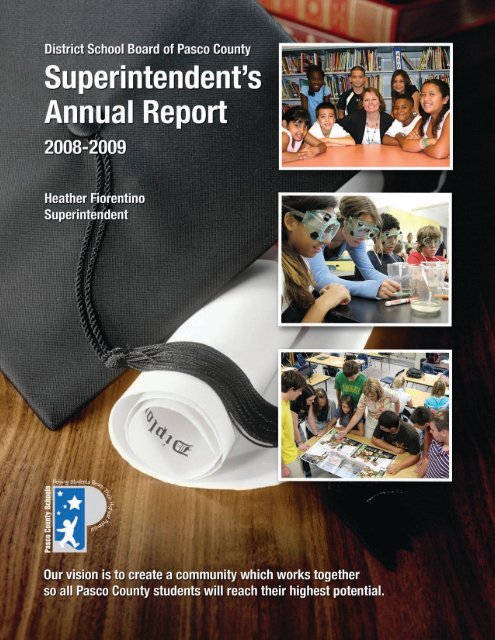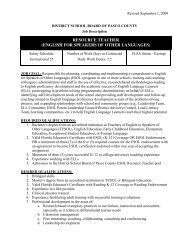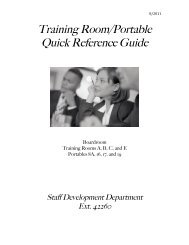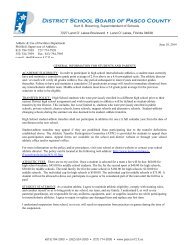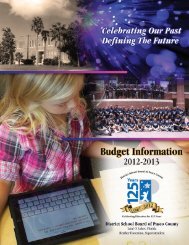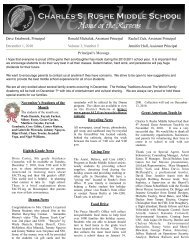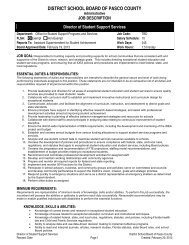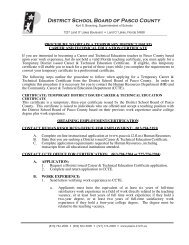Annual Report for 2008-2009 - Pasco County Schools
Annual Report for 2008-2009 - Pasco County Schools
Annual Report for 2008-2009 - Pasco County Schools
Create successful ePaper yourself
Turn your PDF publications into a flip-book with our unique Google optimized e-Paper software.
<strong>Pasco</strong> <strong>County</strong> School Board<br />
Allen Altman<br />
District 1<br />
Joanne Hurley<br />
District 2<br />
Cathi Martin<br />
District 3<br />
Kathryn Starkey<br />
District 4<br />
Frank Parker<br />
District 5<br />
Heather Fiorentino<br />
Superintendent<br />
Ruth B. Reilly<br />
Assistant Superintendent<br />
<strong>for</strong> Curriculum and Instructional Services<br />
Olga Swinson, CPA<br />
Chief Finance Officer<br />
Renalia S. DuBose, Esq.<br />
Assistant Superintendent <strong>for</strong> Administration<br />
David Scanga, Ed.D.<br />
Assistant Superintendent <strong>for</strong> Elementary <strong>Schools</strong><br />
Tina Tiede<br />
Assistant Superintendent <strong>for</strong> Middle <strong>Schools</strong><br />
James T. Davis<br />
Assistant Superintendent<br />
<strong>for</strong> High, Adult and Alternative <strong>Schools</strong><br />
Foreword<br />
The purpose of the Superintendent’s <strong>Annual</strong> <strong>Report</strong> is to provide in<strong>for</strong>mation to assist the district staff<br />
in both monitoring progress toward goals and planning <strong>for</strong> the future. Research reminds us how<br />
important the analyses of data are to healthy organizations (Wheatley, 1999: Stiggins, 1999). Data<br />
provides an indication of where an organization is and gives direction to needed changes. Within this<br />
document various tables and charts will provide data related to starting points, current levels of<br />
per<strong>for</strong>mance and future targets. This report is intended <strong>for</strong> use by school and district level<br />
administrators, school board members, and others who may need detailed in<strong>for</strong>mation about district<br />
initiatives. It is our hope that this report will assist its readers as they prepare to meet the opportunities<br />
and challenges of <strong>Pasco</strong>’s Vision and Strategic Plan.<br />
1
District and Community Profile<br />
(updated 10/19/09)<br />
The District School Board of <strong>Pasco</strong> <strong>County</strong><br />
(DSBPC) is the 11th largest district in Florida<br />
and the 58th largest district nationally<br />
(Sources: Membership in Florida Public<br />
<strong>Schools</strong>, <strong>2008</strong>-<strong>2009</strong>, Florida Department of<br />
Education; National Center <strong>for</strong> Educational<br />
Statistics - Common Core of Data, 2006-2007).<br />
It remains one of the fastest growing school<br />
systems in the state of Florida. As of May<br />
<strong>2009</strong>, the district had 74 traditional public<br />
schools (44 elementary, 15 middle schools, 11<br />
high schools and 4 education centers) and 5<br />
charter schools serving 66,215 students. Two<br />
traditional public schools will be added to the<br />
district in the <strong>2009</strong>-2010 school year. In<br />
addition, <strong>2009</strong> will see the DSBPC open <strong>Pasco</strong><br />
eSchool <strong>for</strong> students residing in the county.<br />
This progressive choice program will expand<br />
educational services to a wider student<br />
community and meet the demands of today’s<br />
digital learners through individualized instruction.<br />
The Department of Education Fall PreK-12<br />
Student Membership <strong>Report</strong> indicates that<br />
<strong>Pasco</strong> schools have grown by over 6,000<br />
11th Largest District in Florida<br />
<strong>Pasco</strong> <strong>County</strong> remains one of the<br />
fastest growing school systems<br />
in the state of Florida.<br />
students (10%) between 2004 and <strong>2008</strong>. It is<br />
projected that <strong>Pasco</strong>’s growth in total PreK-12<br />
student enrollment will reach 86,337 students<br />
by the 2019-2020 school year. The district’s<br />
projected growth will continue to demand the<br />
construction of one new school annually. The<br />
district’s increasing enrollment is also reflected<br />
in the number of students served by the Food<br />
and Nutrition (FNS) and Transportation<br />
departments. In the <strong>2008</strong>-<strong>2009</strong> school year,<br />
FNS staff served over 55,000 breakfast and<br />
lunch meals on an average daily basis. In the<br />
same year, school buses transported more<br />
than 34,500 students twice daily. Driving nearly<br />
8.7 million miles in <strong>2008</strong>-<strong>2009</strong>, the DSBPC<br />
Transportation Department ranked 49th in the<br />
nation with 593 route buses in the fleet (384<br />
used daily).<br />
<strong>Pasco</strong> <strong>County</strong> is just south of the geographical<br />
center of Florida and north of the Tampa-St.<br />
Petersburg area. Located on the Gulf of<br />
Mexico, <strong>Pasco</strong> is part of a nine-county region<br />
referred to as the “Nature Coast.” It was<br />
created in 1887 from the southern part of<br />
Hernando <strong>County</strong> and was named <strong>for</strong> Samuel<br />
<strong>Pasco</strong> who served in the Confederate Army,<br />
the state legislature and in the United States<br />
Senate from 1887 to 1899. The county has<br />
experienced significant population growth<br />
since the 1960’s. This growth began on the<br />
county’s west side along the gulf coast, but is<br />
now occurring most rapidly in the central areas<br />
north of Tampa. <strong>Pasco</strong>’s 745 square miles of<br />
land area contain an interesting mix of<br />
suburban and rural communities.<br />
<strong>Pasco</strong> <strong>County</strong> is Florida’s 12th most populous<br />
county, containing 2.6% of Florida’s citizens.<br />
The county’s population has increased from<br />
344,768 as reported in Census 2000 to<br />
471,028 in July <strong>2008</strong> - a population change of<br />
approximately 37% with 100% of the change<br />
2
attributed to net migration. The Bureau of<br />
Economic and Business Research reports,<br />
however, that <strong>Pasco</strong> will be one of fourteen<br />
counties to lose population during the next two<br />
years due to the economic recession.<br />
According to the U.S. Department of Housing<br />
and Urban Development (HUD), <strong>Pasco</strong> <strong>County</strong><br />
was one of the most impacted communities in<br />
the nation by the <strong>for</strong>eclosure crisis of <strong>2008</strong>.<br />
The collapse of the housing market, along with<br />
a loss of jobs, is likely to keep population<br />
growth at low levels. As the national economy<br />
recovers and the excess supply of housing in<br />
Florida is absorbed, it is expected that<br />
economic growth will pick up again and<br />
increase to more normal levels during the next<br />
decade. The county’s projected total<br />
population of approximately 438,000 in year<br />
2010 reflects a -0.3% decline in growth from<br />
year <strong>2008</strong>. By year 2015, the population will<br />
increase to a projected 475,000 and by year<br />
2030 to about 600,000 returning to normal<br />
average increases. Even with current economic<br />
conditions and possible loss of population,<br />
<strong>Pasco</strong> presently ranks the 7th fastest growing<br />
county in Florida and the 59th fastest growing<br />
county in the United States (Source: U.S. Census<br />
Bureau, Population Estimates <strong>Report</strong>s <strong>2008</strong>).<br />
The majority of <strong>Pasco</strong>’s residents are in the 25<br />
to 44 (26%) and 45 to 64 (24%) age ranges. In<br />
<strong>2008</strong>, the median age was 41.6 years<br />
compared to 40.3 years <strong>for</strong> the state. This can<br />
be attributed to the large population of retirees<br />
residing in the county, with about 21% of the<br />
total population being age 65 or older, as<br />
compared to the state’s figure of 17.4%.<br />
Thirty-one percent (31%) of county residents<br />
were born in Florida and nine percent are<br />
<strong>for</strong>eign born. Families make up 65% of the<br />
households in <strong>Pasco</strong> with an average<br />
household size of 2.6 people and average<br />
family size of 3.2 people (Source: U.S. Census<br />
Bureau, American FactFinder <strong>2008</strong>). <strong>Pasco</strong> is<br />
noted as being in the “path of growth” and<br />
families with young children are drawn to the<br />
area <strong>for</strong> its quality lifestyle, good schools and<br />
attractive environment.<br />
In <strong>2008</strong>, the U.S. Census Bureau American<br />
Community Survey reports that <strong>Pasco</strong> <strong>County</strong><br />
had 220,000 housing units, of which 67% were<br />
single-unit structures, 21% were mobile homes<br />
and 11% were multi-unit structures. Owneroccupied<br />
housing units decreased from 79%<br />
in 2007 to 77% in <strong>2008</strong>, while renter-occupied<br />
housing increased from 21% to 23% over the<br />
same period. <strong>Report</strong>edly, <strong>for</strong>ty-six percent of<br />
owners with mortgages, 18% of owners<br />
without mortgages and 59% of renters in<br />
<strong>Pasco</strong> <strong>County</strong> spent 30% or more of their<br />
household income on monthly owner costs.<br />
<strong>Pasco</strong> <strong>Schools</strong> at a Glance<br />
76 Traditional Public <strong>Schools</strong><br />
45 Elementary <strong>Schools</strong><br />
15 Middle <strong>Schools</strong><br />
12 High <strong>Schools</strong><br />
4 Education Centers<br />
1 Virtual School<br />
5 Charter <strong>Schools</strong><br />
As of September <strong>2009</strong><br />
3
Nearly half of the district’s students<br />
come from families who live in low<br />
socioeconomic conditions.<br />
The <strong>Pasco</strong> Economic Development Council<br />
sites the DSBPC as the largest employer in<br />
<strong>Pasco</strong> <strong>County</strong> with over 9,700 instructional<br />
and non-instructional personnel. Other large<br />
employers include the <strong>Pasco</strong> <strong>County</strong><br />
Government with over 2,200 employees and<br />
the State of Florida Government with almost<br />
1,300 employees. Leading industries in <strong>Pasco</strong><br />
are retail trade (18%), followed by health care<br />
and social assistance (16%) and<br />
accommodation and food services (10%).<br />
Among the most common occupations are<br />
office and administrative support (18%), sales<br />
and related occupations (13%) and food<br />
preparation and serving related occupations<br />
(9%) (Source: Florida Research & Economic<br />
Database, 4th Quarter, October <strong>2008</strong>).<br />
According to <strong>2008</strong> census data, 86% of<br />
people 25 or older were high school graduates<br />
and 19% had a bachelor’s degree or higher.<br />
The state educational figures were 85% and<br />
26%, respectively. Compared to data from the<br />
2000 census when only 78% of <strong>Pasco</strong><br />
residents completed high school and 13% had<br />
bachelor degrees or higher, the most current<br />
statistics indicate the educational level of the<br />
county’s population has risen significantly<br />
(Source: U.S. Census Bureau, <strong>2008</strong> American<br />
Community Survey).<br />
As of May <strong>2009</strong>, the total minority population<br />
served in the district was over 18,000<br />
students. This represents 28% of the district’s<br />
total student body (2% Asian/Pacific, 6%<br />
Black, 16% Hispanic,
<strong>2008</strong> Income Data <strong>Pasco</strong> <strong>County</strong> Florida United States<br />
Median Household Income $42,212 $47,778 $52,029<br />
Per Capita Income $22,822 $26,694 $27,589<br />
1<br />
Figures from 2007 show that approximately<br />
12% of the <strong>Pasco</strong> <strong>County</strong> population lived<br />
below the poverty level and 18% of related<br />
children under 18 were living in poverty. In<br />
addition, nine percent of all families and 26<br />
percent of families with a female head of<br />
household had incomes below the poverty<br />
level (Source: U.S. Census Bureau, American<br />
FactFinder 2007).<br />
With a job base built predominantly on service<br />
occupations, most of <strong>Pasco</strong>’s work <strong>for</strong>ce<br />
commutes outside the county <strong>for</strong> higher paying<br />
jobs. According to the Florida Research and<br />
Economic Database (FRED), <strong>Pasco</strong>’s<br />
unemployment rate of 12.2% <strong>for</strong> July <strong>2009</strong><br />
was slightly higher than Florida’s rate of 11.0%<br />
<strong>for</strong> the same period. The average weekly wage<br />
earned by <strong>Pasco</strong> <strong>County</strong> residents in <strong>2008</strong> was<br />
$671 as compared to $825 <strong>for</strong> the state. This<br />
is equivalent to $16.78 per hour or $ 34,892<br />
per year, assuming a 40-hour week worked the<br />
year around. At this income level, a family of<br />
six or more is eligible to participate in the free<br />
meal program and a family of four or more<br />
qualifies <strong>for</strong> the reduced price meal program.<br />
As of June <strong>2009</strong>, approximately 49% of the<br />
students served by the DSBPC qualified <strong>for</strong><br />
free/reduced lunch and 43 of the district’s 74<br />
traditional public schools had a free/reduced<br />
lunch rate of 50% or greater.<br />
<strong>Pasco</strong> <strong>County</strong> children are reared in a variety<br />
of family environments ranging from extended<br />
families to single parent homes. The Florida<br />
Department of Health reported that the number<br />
of births in <strong>Pasco</strong> to unwed teenage mothers<br />
ages 15-19 increased from 450 in 2006 to 489<br />
in 2007. <strong>Pasco</strong>’s culturally diverse students<br />
from impoverished homes may lack the same<br />
educational foundation and opportunities<br />
experienced by their middle and upper class<br />
peers. Prevailing economic conditions<br />
frequently require one or both parents to work<br />
outside of the home and, in fact, 50% of<br />
families with children six to seventeen years<br />
old have both parents in the labor <strong>for</strong>ce. Of<br />
married couples with children under 18, over<br />
55% of the females are employed either with<br />
or without their husbands in the labor <strong>for</strong>ce. Of<br />
female single parent households, 87% are in<br />
the labor <strong>for</strong>ce. As a result, large numbers of<br />
parents are required to find quality childcare<br />
and after school activities <strong>for</strong> their children.<br />
The District School Board of <strong>Pasco</strong><br />
<strong>County</strong> is the largest employer in <strong>Pasco</strong><br />
<strong>County</strong> with over 9,700 instructional<br />
and non-instructional personnel.<br />
5
Data from the <strong>2008</strong> school year reflect that<br />
high school graduation and dropout rates are<br />
improving at both the district and state levels.<br />
The district’s graduation rate continued to<br />
exceed statewide totals growing from 73.7% in<br />
2007 to 79.5% in <strong>2008</strong> as these numbers<br />
compare favorably to respective totals of<br />
72.4% and 75.4% over the same period at the<br />
state level. The district’s graduation rate has<br />
increased 4.6% over the five-year period from<br />
2003 to <strong>2008</strong>. 2<br />
Current data also reveal that the dropout rate<br />
has decreased from previous year district and<br />
state level totals. In <strong>2008</strong>, the district dropout<br />
rate declined to 2.1% from 3.5% in 2007. The<br />
district’s 3.5% dropout rate was slightly higher<br />
than the State of Florida’s dropout rate of<br />
3.3% in 2007; however, the 2.1% dropout rate<br />
was noticeably less than the state’s reported<br />
2.6% in <strong>2008</strong>. (Source: Florida Indicator<br />
<strong>Report</strong>s 2007-<strong>2008</strong>). 3<br />
The Florida Legislature recognizes and rewards<br />
school districts that demonstrate the ability to<br />
consistently maintain high per<strong>for</strong>ming status.<br />
The DSBPC met the eligibility criteria specified<br />
in statute <strong>for</strong> first year designation as a <strong>2009</strong>-<br />
2010 Academically High Per<strong>for</strong>ming School<br />
District. Improvements in the graduation and<br />
drop out rates are indicative of the district’s<br />
commitment to provide a rigorous and relevant<br />
learner-focused curriculum and the goal of<br />
increasing the percentage of students<br />
graduating from high school prepared <strong>for</strong><br />
success in the present and future economies.<br />
High school graduation and dropout rates<br />
are improving at both the district and<br />
state levels when compared to previous<br />
year totals.<br />
6
District Vision Committee <strong>2008</strong> - <strong>2009</strong><br />
Rob Aguis, Community, Career and Technical Education Department<br />
Kim Anderson, Pine View Middle School<br />
Mari Blank, Parent<br />
April Baughn, Parent<br />
Gerry Brown, Facilities and Maintenance Department<br />
Elicia Cefalo-Cox, Sanders Elementary School<br />
Terry Dusek, Parent<br />
Michael Cloyd, Curriculum and Instructional Services Department<br />
Christine Crocco, University of South Florida<br />
Elena Garcia, Curriculum and Instructional Services Department<br />
Gwen Gideon, Marchman Technical Education Center<br />
Tiffany Gocsik, Veterans Elementary Schoo<br />
Jennifer Hull, John Long Middle School<br />
Joanne Hurley, School Board Representative<br />
Martin Ilivicky, Community Member<br />
Dr. Peggy Jones, Research and Evaluation Department<br />
Rick Kurtz, Food and Nutrition Services Department<br />
Teresa Love, Cypress Elementary School<br />
John Mann, Leadership Department<br />
Marti Meacher, Staff Development Department<br />
Maureen Moore, Communication Department<br />
Robert Moore, United School Employees of <strong>Pasco</strong><br />
Rebecca Musselman, Seven Springs Middle School<br />
Jill Nielson, Curriculum and Instructional Services Department<br />
Ruth Reilly, Assistant Superintendent <strong>for</strong> Curriculum and Instructional Services<br />
Georgina Rivera-Singletary, <strong>Pasco</strong> High School<br />
Frank Roder, United School Employees of <strong>Pasco</strong><br />
Denise Orlando, Finance Department<br />
Michele Perry, Parent<br />
Dr. David Scanga, Assistant Superintendent <strong>for</strong> Elementary <strong>Schools</strong><br />
Dr. Renee Sedlack, Human Resources Department<br />
Kathy Steiner, Curriculum and Instructional Services Department<br />
Angie Stone, Sunlake High School<br />
Hope Schooler, Gulf Trace Elementary School<br />
Olga Swinson, Chief Finance Officer<br />
Erika Tonello, Schrader Elementary School<br />
Allison Vanderbilt, Research and Evaluation Department<br />
Amelia Van Name Larson, Student Services Department<br />
Monica Verra, Exceptional Student Education Department<br />
Dr. Carol Walker, Saint Leo University<br />
Rachel Zick, Charles S. Rushe Middle School<br />
22
District School Board of <strong>Pasco</strong> <strong>County</strong><br />
7227 Land O’ Lakes Boulevard • Land O’ Lakes, FL 34638


